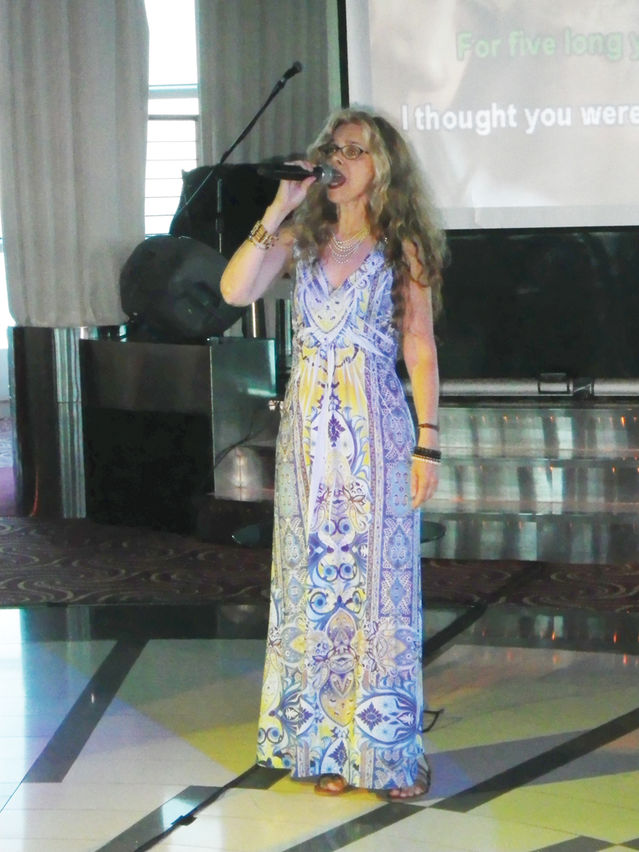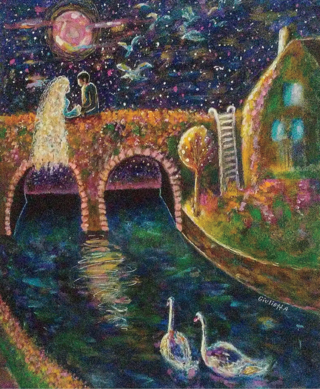Finding a New Voice
When a rare disorder impaired Giulietta Nardone's voice, she began to embrace powerful new forms of self-expression.
By Giulietta Nardone published November 6, 2018 - last reviewed on January 2, 2019
One morning, nearly 20 years ago, I called my sister to discuss our plans for the weekend.
"Your voice sounds froggy," she said.
Once she mentioned it, I noticed my voice was hoarse, and a slight burning sensation was creeping down my throat. I dismissed the symptoms as vocal strain from karaoke. I liked to learn one new tune each week, but clearly Whitney Houston's "I Have Nothing" was out of my league. I figured my voice would heal in a few days.
It got worse.
Six months later, most of my words sounded shaky and strained. My melodic voice was replaced by a forced, choppy rasp. I struggled to pronounce words and phrases I used to utter with ease, and some completely vanished from my vocabulary because I could no longer formulate certain consonants. Even my own nickname, Julie, was impossible to say. Every time I attempted the "j" sound, a "d" emerged instead. I grew used to picking up pizza orders under "Dulie," "Dewey," and sometimes, bizarrely, "Elaine."

I felt frustrated and scared, but my real heartbreak occurred when I realized I could no longer sing. Karaoke was a staple in my life. I loved the challenge of mastering new songs and the sense of belonging and comfort I found in the bar with friends, no matter what else was happening. But now my voice had transformed into a sputtering, crackling mess. I was too proud to embarrass myself on stage. My joie de vivre seemed to disappear with my words.
Frankly, I no longer knew what to do with myself.
For the next three years, I drifted from one voice specialist to another. No one could give me any real answers, although I got plenty of suggestions, like "steaming" my voice, starting every word with "h," or buzzing "mi, mi, mi" behind my nose. Nothing relieved my symptoms for more than a few minutes.
Finally, after a battery of tests at a large Boston hospital, my new doctor announced, "You have spasmodic dysphonia." It's a rare neurological voice disorder, he told me, characterized by vocal cord spasms. "You will be mute within five years."
"How do I cure it?" I asked with a knot in my throat.
He frowned. "You don't," he said bluntly.
I wanted to throw the devastating news back at him. How could I interview for the new marketing job I wanted? Or express my opinions at public meetings? Or banter with friends over cocktails?
I'd mused occasionally about how horrible it would be to lose my eyesight or hearing. But my voice? It was my gateway to the world.
There was a treatment for my condition, the doctor informed me, a regimen that involved injecting my vocal folds with Botox. Afterward, I would drool and talk in a whisper for a few days. Then my voice would sound almost normal for a few months—until it didn't, at which point I'd need to repeat the process, at higher and higher doses. I'd be chained to the treatment, until, at some arbitrary point, it would stop working.
I declined the Botox.
If this was my voice now, I would simply learn to live with it. But I didn't want to be the pitied person, the damaged one whispered about when she left the room. So, except for my family, my husband, and a few close friends, I told no one about the diagnosis. I tried to hide my condition from everyone else, a nonsensical strategy given its physical nature.
Faced with well-meaning inquiries ("Sounds like you have a really bad cold" or "Are you okay? You seem upset"), I played along. "Recovering from a vicious cough," I'd lie. Once at a town meeting, I spoke about buying a large plot of land. The next day my quote appeared in a newspaper article. Below someone had commented, "Her voice sounds like nails on a chalkboard."
If only that anonymous person knew how hard it was for me to make any sound at all.
A few years later, a colleague asked me to join a creative writing group. Even though I hadn't written since high school, I agreed to participate. I wrote a funny piece about dancing to disco music in my laundry room and found it surprisingly liberating to share my inner world. It awakened a new channel of creativity, and I enrolled in a few online writing classes. When an editor finally accepted my first essay, I was ecstatic.
I also took up painting, a hobby I had left behind in junior high school. My first two attempts were garish caricatures, but the third more clearly depicted the intended subject: a lovely, colorful antique lock.

I slowly gained enough confidence to lead my own intimate writing and painting classes at local art centers. I'd never imagined myself encouraging others to reconnect with their creativity, especially with my speaking challenges, but students didn't mind my damaged voice. They, too, wanted to rediscover themselves.
Before my spasmodic dysphonia diagnosis, my idea of expression was narrowly limited to speaking and singing. Now, it widened to include everything from fashion and architecture to cooking and tinkering.
During this period of self-expansion, I stumbled on a quote from Alexander Graham Bell. "When one door closes, another opens; but we often look so long and so regretfully upon the closed door that we do not see the one which has opened for us." I might have lost my speaking voice, but there were so many other avenues to express myself that I no longer mourned its decline.
Eight years after my diagnosis, I spotted a business card on a bulletin board at the gym and pulled it down for a closer look. The card belonged to a singing teacher whose name was also Julie. I decided the coincidence of our sharing the same first name was a sign. Although I had discovered fulfilling new forms of expression, perhaps I could explore singing again.
I met with Julie weekly, and she was determined to reconstruct my singing voice. She created new vocal exercises just for my condition, which I practiced diligently. At first, she concentrated on the sounds I could actually make—percussive sounds like "b," "k," "d." Then she showed me how to visualize where I wanted the sound to go. I released the vowels "a, e, i, o, u" as I pictured the sound rising up to the ceiling and out the window.
Julie was essentially trying to elevate my voice to a higher pitch, one less hindered by my vocal spasms. My natural speaking voice, prone to cracks and scratchiness, falls in a lower register, but shifting to a higher level seemed to help. Other speech therapists had encouraged me to speak in a higher pitch, but Julie's visualization techniques finally propelled my voice into a new space, one that I could reach more easily by singing than by speaking. Transferring my voice to a higher pitch may have alleviated the strain that the doctor believed would make me mute.
To my surprise and delight, my new sound also created a richer singing voice than I had had before. As long as I followed Julie's approach of swooping over the cracks in my voice, formerly impossible, higher-range notes came easily to me. Over and over, she encouraged me to "let go, get out of your own way, and trust that your voice will find the notes."
And when, with some trepidation, I returned to the karaoke stage, I sounded better than ever. I even nailed "I Have Nothing," the Whitney Houston song I'd botched so long ago. "You gave me the chills," said a woman at the next table, when the applause from my performance subsided. "I thought you were channeling Whitney."
Today I still get frustrated by my raspy speaking voice, the need to pick up pizzas for "Dewey," and the constant echo of "What did you say?" But I also appreciate that my old, condensed notion of self-expression has expanded. By writing, painting, and instructing, I've developed a more adventurous attitude—and I've returned to karaoke as a stronger, freer singer.
